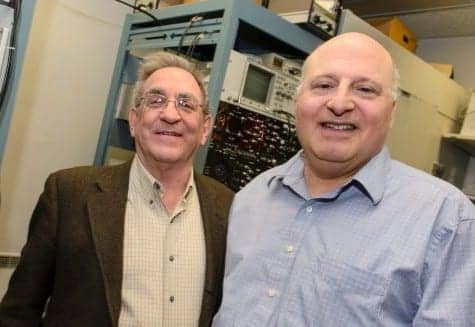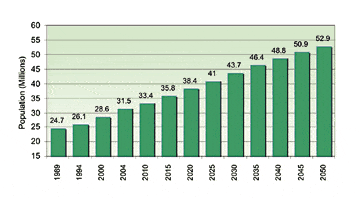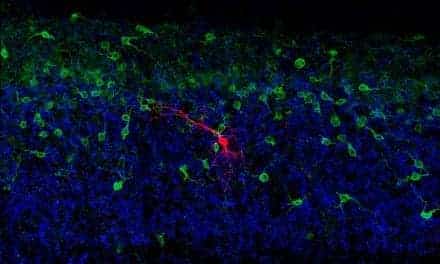Many adults report difficulties hearing in everyday situations, despite having hearing test results that are normal or near-normal. Now neuroscience researchers at UConn School of Medicine have developed a hearing test that can identify hearing loss or deficits in some individuals who are considered to have normal or near-normal hearing in traditional tests.
“We have a validated technique to identify ‘hidden’ hearing deficits that would likely go undetected with traditional audiograms,” said Leslie R. Bernstein, PhD, professor of neuroscience and surgery at UConn, who conducted the study with Constantine Trahiotis, emeritus professor of neuroscience and surgery. According to a recent announcement in UConn Today, their newly developed hearing test measures a person’s ability to detect binaural changes in sounds presented at levels of loudness that are close to those experienced in normal conversations.
The binaural system plays a fundamental and predominant role in the ability to localize sounds, to understand conversation in noisy places such as busy restaurants, and to attend to one of multiple, simultaneous sounds.

UConn neuroscience researchers Constantine Trahiotis, PhD, and Leslie R. Bernstein, PhD, in the Psychoacoustics Laboratory at UConn Health. (Photo: Janine Gelineau/UConn Health)
In developing their validated hearing test, the researchers studied 31 adults ages 30 to 67 with normal or near-normal audiograms. They found that listeners who have essentially normal clinical hearing test results may exhibit substantial deficits in binaural processing. The results of the study have been published in a November 2016 online edition of the Journal of the Acoustic Society of America.
“Our study shows that our novel binaural hearing test can help early identify vulnerable populations of listeners, and perhaps help determine when critical interventions are warranted,” said Trahiotis. Professors Bernstein and Trahiotis, who have been colleagues at UConn School of Medicine for 29 years, are considered to be at the forefront of binaural auditory research.
Bernstein notes that acquired hearing loss from excessive noise exposure has long been known to produce significant hearing deficits. The new research suggests that hearing loss may be even more widespread than was once thought. For example, experts in the hearing research field used to think that post-concert hearing loss or ear ringing was often only a temporary injury that would subside. But this new research and mounting evidence may change expert opinion.
Hearing problems pose substantial societal and economic problems for the approximately 15% of American adults who report some level of hearing loss. It is estimated that 360 million people worldwide have disabling hearing loss, with the World Health Organization (WHO) projecting that 1.1 billion teenagers and young adults are at risk of hearing loss due to the lingering effects of excessive noise from personal audio devices used with earbuds or headphones, and loud concerts.
“Greater understanding of normal hearing and the early detection of any underlying slight hearing deficits in supposed ‘normal’ listeners could help practitioners have a better chance of identifying ways to slow the progression of debilitating hearing loss in one’s lifetime, and even possibly finding future ways to restore it,” said Trahiotis.
The team’s research is funded through a $1.5 million grant by the Office of Naval Research. The US Navy has a keen interest in finding new ways to protect the hearing health of its workforce, some of whom are known to be at high risk of noise-induced hearing loss caused by exposure to excessively loud sounds.
Source: UConn Health, UConn Today
Image credits: Janine Gelineau, UConn Health; © Monkey Business Images | Dreamstime.com






Brands should not be recommended if you do not know what the persons hearing loss is. Some brands are better for high frequency losses, some brands have issues with feedback for severe losses therefore not being to amplify consonants sounds appropriately. Go to an audiologist that performs real ear.
Iam a medical doctor in Coimbatore ,Tamil Nadu . How and where can I contact your dealers. Thq
I presently wear 2 Beltone Boost Plus 17 BTE. I hear phone and TV thru their streaming links. I still do not understand speech in one on one conversations. Is there any new Technology coming soon or a better HA available. Price is not a concern
Try Oticon Opn
You should contact your audiologist for fine tuning. But it may depend on your audiogram. If you are wearing beltone boosts I imagine you have more than a mild hearing loss. If your hearing loss is severe to profound, raising the volume will not help clarity and the best hearing aids in the world cannot help certain hearing losses. You may be a cochlear implant candidate if your speech understanding one in one is less than 50-60% with your hearing aids set correctly. Ask for aided testing using the AZ Bio Sentences test. See another audiologist if they try to sell you new hearing aids as the only option. Beltone is similar or same as Resound. You may benefit from an FM system or a remote microphone if background noise is too loud.